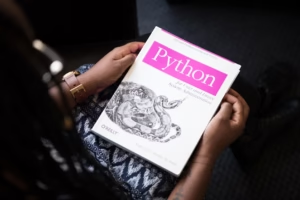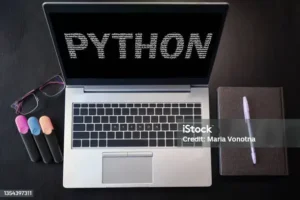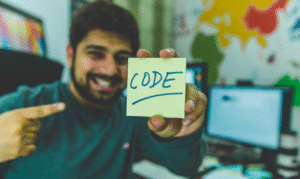
You use tech every day: sending a WhatsApp, browsing Flipkart, tracking Swiggy orders. But have you ever wondered how it all works? Learning the basics of Python is your invitation to the control room of the tech universe. And we can vouch, it’s not as complicated as it sounds.
This guide breaks down the basics of Python in a way that makes sense even if you’ve never touched code. It’s for anyone who’s ever said, “I want to learn, but where do I even start?”
What is Python?
Python is a programming language developed by Guido van Rossum in 1991. Python’s charm lies in its clean, readable structure. From the moment you start typing your first line of code, it feels like you’re talking to your computer in plain, logical sentences. Its creator himself said, “Python inherits a lot of that focus to make it very simple, easy to understand, easy to remember and easy to learn.”
No confusing curly brackets or overly technical terms, just code that reads almost like normal conversation. It’s the reason why Indian ed-tech platforms like Byju’s and WhiteHat Jr. teach Python to kids as young as 10.
Now that we’ve uncovered what Python is, let’s break down how you can start learning it from the basics.
Top 5 Benefits of Learning the Basics of Python in 2025

Still wondering if learning Python is worth your time? Let’s put it this way: your future self, sitting in a job you love (or building a side hustle), will thank you for learning Python today. Let’s unpack the benefits that make it all worth it.
1. Better Job Opportunities
Python is the language behind some of the most in-demand jobs today. From tech giants like Infosys and TCS to startups working in AI and fintech, everyone’s hiring Python developers. According to naukri.com, Python continues to dominate job postings in India, with thousands of roles open for both freshers and experienced professionals.
2. Easy Learning
Python doesn’t speak in riddles. Its syntax is so clean and readable that even someone with zero tech background can start writing basic programs in no time.. That’s why it’s the first language taught at many IITs and Indian coding platforms, because it welcomes beginners with open arms.
3. Free Resources
With such a large user base, finding support is easy. From YouTube tutorials to active Reddit forums, the Python community is one of the most active in the world, and chances are, someone has already faced (and solved) your exact problem.
4. Learn Advanced Tech Skills
Once you learn Python basics, it opens doors to advanced topics like machine learning, AI, data science, and web development. It acts as a foundation you can build on gradually.
Read Also: Machine Learning 101: A Beginner’s Guide to Smart Systems
5. Remote Work Opportunities
The great thing about Python? You don’t have to wait years to make it useful. Even with just the basics, you can explore real gigs on sites like Fiverr or Upwork. Many companies and clients hire freelancers for short-term Python work, especially in areas like web development and automation. It’s a practical way to gain experience and earn a side income at your own pace.
Step-by-Step Methods to Learn Python for Beginners
Learning the basics of Python is best achieved with structure and intention. Here’s a refined roadmap specifically crafted for beginners who want clarity and confidence:
1. Decide Why You Want to Learn Python
Before you dive in, figure out your “why”.
Start by asking yourself, ‘What do I want Python to help me with?’ Automating tasks, analysing data, building an app, or just exploring the world of code? According to Internshala’s survey, over 36% of students chose Python to boost their job prospects, while 28% aimed to upskill overall. Having a purpose keeps motivation high and prevents learning burnout.
2. Pick the Right Platform (And Stick to It)
This is where many learners get stuck, jumping from one resource to another. Choose one learning path and follow it through for at least a few weeks.
- Interactive platforms like Mimo and Codecademy offer instant feedback, which is great if you’re learning on the go.
- Short-term courses like Coursera’s Python for Everybody guide you with expert-led video lessons and quizzes.
- YouTube channels like Telusko or CodeWithHarry.
Want to skip the research? We’ve done the homework for you. Browse our top picks of free Python courses you shouldn’t miss!
3. Get Comfortable with Python on Your Device
Once you pick a resource, install Python 3 on your computer; it’s available for Windows, macOS, and Linux. Then, choose a code editor: Thonny is simple, while Visual Studio Code offers more features. Setting this up might seem technical, but once done, you’ll spend more time learning logic and less time troubleshooting your tools.
4. Build Knowledge One Concept at a Time
Diving into Python is like learning a new language; start slow. Begin with simple ideas: printing text, understanding variables, and using basic data types. Once that clicks, gradually move on to control flow (if-else statements and loops), followed by functions. Experts agree: mastering one small concept before moving on is far more effective than trying to learn everything at once, as it builds confidence and clarity.
5. Practice Smarter, Not Just Harder
Instead of passively watching tutorials, open your code editor and type along. Even better, make small tweaks. Change variable names, add print statements, and try “what if” experiments. Make a habit of coding for just 20–30 minutes a day.
Try this:
Start a #30DaysOfCode journal, and post your daily learnings on X (Twitter) or LinkedIn. You’ll be surprised how many people join in and cheer you on.
6. Join a Community & Stay Curious
Learning is easier and more fun when you’re not alone. Join communities like:
- r/learnpython on Reddit
- Python India Discord or Telegram groups
- LinkedIn Python circles or workshops near you
These places aren’t just for Q&A; they help you stay accountable, discover trends, and maybe even land your first gig.
7. Build Tiny but Real Projects
Theory can only take you so far. Once you’re past the basics, build small, real-world tools. Some easy wins:
- A calculator or tip-splitter
- A birthday reminder bot
- A currency converter
Projects give you the thrill of building something useful, and that’s what keeps you coming back.
💡 Need a quick daily project idea? This “60+ Python Project Ideas” guide from Dataquest offers challenges perfect for beginners wanting practical experience.
Also Read: Top 20 Selenium Automation Testing Interview Questions for QA
Basics of Python Glossary: What They Really Mean

When you’re just starting with Python, some words can sound more confusing than helpful. Indentation? Argument? If statement? What do they even mean?
Don’t worry, this isn’t your engineering professor’s glossary. We’ve broken down some of the most common Python terms in simple, everyday language so that even if you’re not from a tech background, you won’t feel lost. Bookmark this, you’ll thank yourself later!
1. Indentation
Indentation is the space added at the beginning of a line in your code to show what belongs inside a block. In Python, it’s not just for aesthetics; it actually defines where your code starts and ends. Other languages may use brackets to define blocks, but in Python, the right indentation is non-negotiable. Miss a space, and your whole code could throw a tantrum.
2. Syntax
Syntax is like grammar for programming. It’s the set of rules that defines how your Python code should be written so the interpreter understands it. Missing colons, extra brackets, or forgetting indentation are all syntax errors. For beginners, it’s totally normal to trip up here at first, but soon enough, you’ll start noticing these patterns instinctively.
3. Variable
A variable is just a label you stick on a piece of data so you can use it again. It’s like assigning a label to a box so you know what’s inside. Like writing your mom’s number under “Mumma” in your phone, it stores information in a name that’s easy to call later. This makes your code more readable and your data easier to manage.
4. Function
Functions are reusable chunks of code that do a specific task. Think of them as mini-programmes within your programme. You define them once and then use them wherever needed. For example, if you need to convert temperatures from Celsius to Fahrenheit often, writing a function for it will save you from repeating the same lines over and over.
5. Argument
When you call a function, you often need to give it extra details; those are called ‘arguments’. They are the actual values you pass into a function to help it do its job. So, if you have a function that calculates someone’s age based on their birth year, the year you pass in is the argument. Without arguments, most functions would be pretty useless.
6. Program
A program is just your full set of Python instructions working together to get something done, whether that’s a calculator, a chatbot, or even a mobile game. It’s the finished puzzle made from all the smaller pieces, like variables, loops, and functions. If you’ve ever created a small script that prints your name or adds two numbers, congrats, you’ve written a program!
7. If Statement
An if statement is Python’s way of making decisions. Want to check if someone is 18 or older? Or if your score is high enough to pass a level in a game? That’s where if statements come in. If the statement is correct, the program can say, “Excellent job!” This is where your code starts to behave differently based on inputs and logic.
8. Loop
When you want to repeat something (say, 100 times), a loop’s your best friend. It saves you from writing the same lines again and again. Python mainly uses for and while loops, and once you get the hang of them, you’ll wonder how you ever coded without them.
9. List
A list is a way to store a bunch of values in one place. Think of it like a shopping list; you write it once, but it holds multiple items. In Python, you can make a list of numbers, names, or even other lists. They’re one of the most powerful and flexible tools you’ll use early on, especially when working with data.
10. Boolean
Booleans are the decision-makers in Python. They return only two outcomes: True or False. No maybes, no grey areas, only black or white. You’ll run into Booleans a lot when dealing with conditions and decision-making.
11. Module
Modules are files with pre-written Python code that you can use in your own programs. Instead of writing everything from scratch, you can import a module to handle things like math calculations, working with dates, or generating random numbers.
12. Object-Oriented Programming (OOP)
Object-Oriented Programming (OOP) is a method of structuring code by grouping related data and functions into objects. It helps you model real-world things like users, bank accounts, or orders in a more natural way. While it might seem a bit heavy for beginners, understanding objects, classes, and inheritance will eventually take your skills to the next level.
Final Thoughts
It’s funny how the basics of Python often begin with just one line, print (“Hello, world!”), Yet it can lead you to worlds you’ve never imagined. Even the biggest tech startups once began with beginner code and uncertain fingers on a keyboard.
So here’s a thought: What would you build if you knew Python? A tool? A game? A solution your dadi would proudly forward on WhatsApp?
Drop your answer below, and let’s see how weird, wild, or wonderful our ideas can get.
FAQs
1. Is Python really beginner-friendly, even if I don’t have a tech background?
Yes, absolutely. Python was designed to be uncomplicated and straightforward. Its syntax (grammar) is close to everyday English, making it a top choice for beginners.
2. What makes Python great for AI and machine learning?
There’s a reason most ML tools speak Python; it’s simple and insanely adaptable. And if you’re still wondering why, here’s a short video where Guido van Rossum, its creator, answers it perfectly. Watch here.
3. How long does it take to learn the basics of Python?
It depends on your pace, but with consistent practice (say, 30–45 minutes a day), you can grasp the basics in 4 to 6 weeks.
4. Can I learn Python without a laptop?
Absolutely. While a laptop definitely makes things easier, you can begin your Python journey using your smartphone. There are apps like Pydroid, SoloLearn, and QPython that let you write and run Python code right from your phone.
5. Do I need to know math to learn Python?
Nope! Unless you’re diving deep into data science or machine learning, basic school-level math is enough. Python is more about logic than long equations.





